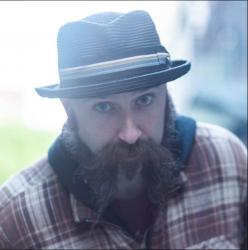The Cult of the Machine at the de Young
The room is dominated by a chromed-out, cream-colored bullet on four wheels. The streamlined 1937 Cord Phaeton convertible is breathtakingly flawless. It is flanked by other sculpted pieces of shimmering metal. They could be called Art Deco, Arte Moderne, or even Streamlined Moderne, but what ties them all together is a quality of precision.

The Cord Phaeton reflects in the blue cobalt surface of a 1935 “Nocturne” radio designed by Walter Dorwin Teague and manufactured by the Sparton Corporation
Welcome to the Cult of the Machine, a new exhibit running March 24-August 12 at the de Young Museum, which harkens back to the beginning of the twentieth century. America was sending up skyscrapers, building bigger boats, and flying around in airplanes. In 1913, Henry Ford began cranking out cars on his newly-devised assembly line and, in 1915, the first telephone call from New York to San Francisco was placed.

“Coil of Strip Stainless Steel” made by the American Steel and Wire Company, donated to the Museum of Modern Art, New York, for its 1934 “Machine Art” exhibition.
The industrial revolution was off and running!
While many people feared their jobs would be replaced by robots, there was a resounding belief that mechanization would usher in a utopia free from the drudgery of manual labor. Artists enamored by the stark, sterile beauty of machinery, gave rise to a little known but pervasive art movement called Precisionism.
Perhaps no painter was as enthralled with the mechanical aesthetic as much as Charles Sheeler (1883-1965) who is credited as saying: “What a beautiful world it would be if there were no people in it.” The de Young has gathered a great number of his works, including four out of six paintings from his Power series, which were originally commissioned for Fortune Magazine and published in 1940.
Sheeler’s paintings are gorgeous and meticulous. While focusing on them through a camera lens, they’re hard to distinguish from a photograph. It is fitting then, that he was renowned as a photographer as well as a painter. He would frequently paint from pictures he’d taken, often adhering strictly to the original composition captured by the camera.
Directly next to the Power paintings in the exhibit is Aeroplane by Elsie Driggs (1898-1992), who was inspired by her first airplane trip from Detroit to Cleveland in 1928. Like Sheeler, Driggs was very taken by the new, emerging technology and made trips just to study factories. She described her 1927 painting Blast Furnaces as “a potpourri of all the forms I saw on my way to Pittsburgh
There were not many women associated with Precisionism, but Driggs had good company with Georgia O’keeffe, whose paintings of the New York skyline fall in stark contrast with her better-known, nature-centric pieces. Her work City Night calls to mind the urban loneliness depicted in the works of Edward Hopper.
While similar in their depiction of the new American metropolis, Hopper’s works were not chosen to be included because — although they are architectonic — they don’t have that strict adherence to machine-like lines that define precisionism.
With Hopper absent, it was intriguing to see a work by Peter Blume incorporated into the de Young exhibit. Blume’s painting “The Rock” hung next to Hopper’s famous “Nighthawks at the Diner” in the Chicago Art Institute. While the Rock speaks to Blume’s use of magical realism — depicting a struggling working class, building construction and a strange, ethereal mountainous rock in the center of the composition — it doesn’t have the pure geometry presented in his haunting “Pig’s Feet and Vinegar.”
The bleak and barren potential of machinery is addressed by the exhibit. There’s a room devoted to the very real threat of losing jobs to robots. There’s also an interactive panel where visitors are asked to choose three words that describe technology for them.
In the final gallery, the words chosen are projected onto a wall, The size of each word reflects how often it was selected.
On the opposite wall, words found in popular magazines from the 1920s and ’30s are projected, again with frequency determining size.
“Here in the heart of the Silicon Valley, where companies are making better technology,” says curator Emma Acker. “I hope we might pause and strive to adapt them to the most constructive ends possible.”
Between the two walls, is a single painting: “War Bride” by Clarence Holbrook Carter (1904-2000). This could be described an example of magical realism as well as precisionism. It certainly gets across its point that technology has become our new religion.
This idea is complemented by Charles Demuth’s ominously title painting of factory smoke: “Incense of a New Church.” And Sheeler even went so far as to say the “factories are our substitute for religious expression.” A video of Charlie Chaplin getting sucked into a machine plays on a loop in one room and a 1930 film called “Mechanical Principles” plays in another. There are also some dazzling, tech-centric sculptures.

Tower forms by John Bradley Storrs
There’s also a good representation of the Shaker furniture that more than one precisionist painter took an interest in. The Shaker’s were a religious sect formally known as the United Society of Believers in Christ’s Second Coming. They were proponents simplicity and honesty. The minimalistic designs of their furniture scratched that pure geometry inch in the precisionists.
We love machines for their simplicity — however complicated, they work on principles far less confusing than the psychology of any human. Perhaps what we really want is for things to be made easier for us. We’d rather push a button and be elevated sixty floors than hike a mountain.
I know I’d rather cruise around in that Phaeton than walk downtown.
Cult of the Machine @ The de Young
March 24, 2018 – August 12, 2018
Tickets & Information















